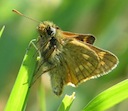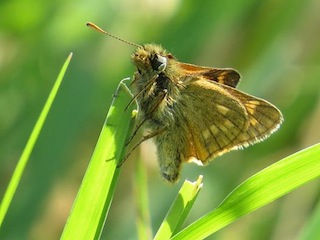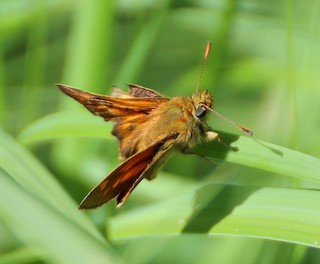 Watch out for Large Skippers from May to September in meadows, and in woodland rides and glades.
Watch out for Large Skippers from May to September in meadows, and in woodland rides and glades.
Photo: Steve Townsend
Scientific name: Ochlodes sylvanus (previously known as Ochlodes venata)
Cornish name: ‘Tikki-dui’ is the general word for butterfly
Conservation status: None
What to look for:
- Colouring: Orange upperwing with brown wing edges, and pale orange spots on the underside. Males have a black line in the centre of each forewing.
- Size: Wingspan of up to 3.5 cm. Females are slightly larger.
- Where: Areas of long grass that are fairly sheltered; in Cornwall, the distribution is markedly coastal.
- When: The adult is on the wing from June (May in Cornwall) to early September.
- Similar species: The Small and Essex Skippers lack the faint chequered patterning on the wings of the Large Skipper. The rare and far more localised Silver-spotted Skipper (not present in Cornwall) is similar, but the spots on the underside of its wings are silvery compared to the pale orange spots of the Large Skipper.
 You have to be quick if you want to photograph or take a close look at a Large Skipper – these butterflies are very active, pausing only briefly to nectar at a flower before bustling off to the next one. Wait for them to settle, basking in the sun with their forewings raised, in order to admire the subtle beauty of this brownish-orange butterfly. The males often bask in sunny locations, waiting for females to pass by.
You have to be quick if you want to photograph or take a close look at a Large Skipper – these butterflies are very active, pausing only briefly to nectar at a flower before bustling off to the next one. Wait for them to settle, basking in the sun with their forewings raised, in order to admire the subtle beauty of this brownish-orange butterfly. The males often bask in sunny locations, waiting for females to pass by.
The Large Skipper has a long flight period, from June to September. Don’t be fooled by the first part of its name: this is a small butterfly, and not much larger than the Small Skipper. The second part of its name is very appropriate, however: the Skipper group of butterflies was named for the distinctive ‘skipping’ flight pattern of its various members.
 The main larval foodplants comprise grasses: Cock’s-foot is mostly used, and occasionally the butterfly has been recorded to make use of Purple Moor-grass and False Brome. The female lays the eggs on the underside of the grass. After hatching, the caterpillar curls a leaf round itself, fixed with silk, within which it feeds. It hibernates through the winter before emerging in the spring to continue feeding and finally pupating in May. In Britain, Large Skippers have a single brood.
The main larval foodplants comprise grasses: Cock’s-foot is mostly used, and occasionally the butterfly has been recorded to make use of Purple Moor-grass and False Brome. The female lays the eggs on the underside of the grass. After hatching, the caterpillar curls a leaf round itself, fixed with silk, within which it feeds. It hibernates through the winter before emerging in the spring to continue feeding and finally pupating in May. In Britain, Large Skippers have a single brood.
Did you know…?
…The black line on each of the male’s forewings is formed of scent scales: these are scattered during courtship to attract the female.
…Males are territorial, and will launch themselves from their perch to deter ‘invaders’.
More information and references:
Chinery, M., 2004. Collins Complete Guide to British Insects. Collins, London.
Mansell, E. and Newman, L.H., 1968. The Complete British Butterflies in Colour. Ebury Press and Michael Joseph, London.
Wacher, J., Worth, J. and Spalding, A., 2003. A Cornwall Butterfly Atlas. Pisces Publications, Newbury, Berkshire.
Whalley, P. and Lewington, R., 2009. The Pocket Guide to Butterflies. Bounty Books, London.
Published: June 2014
Author: Amanda Scott
Photos: Upper, Steve Townsend; lower, Amanda Scott
